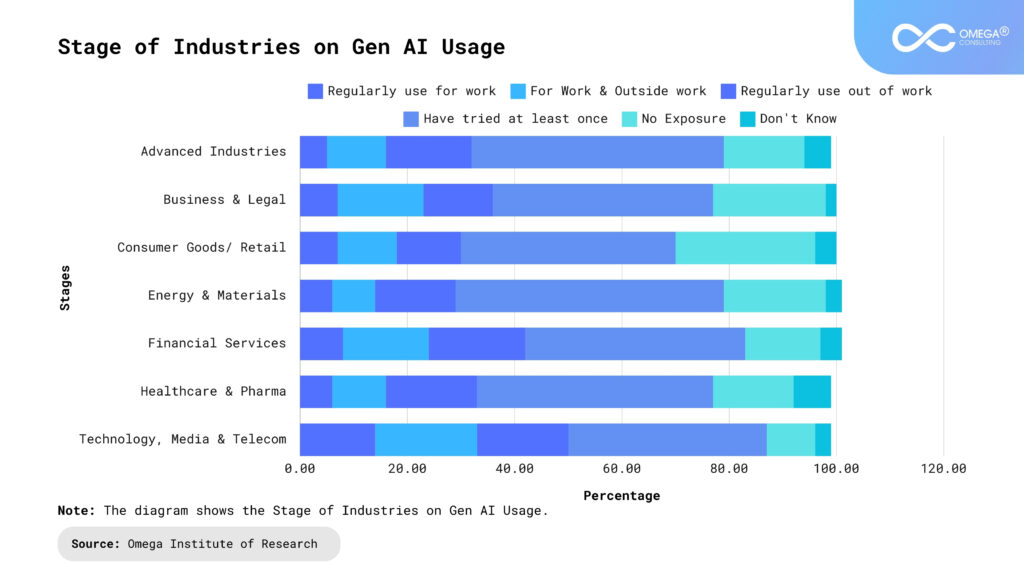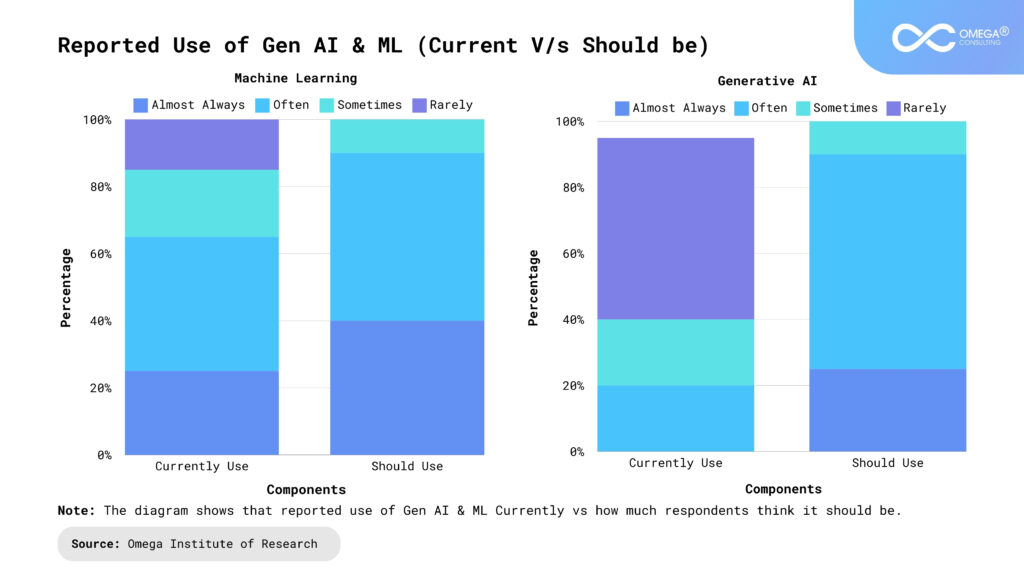- Industries
Industries
- Functions
Functions
- Insights
Insights
- Careers
Careers
- About Us
- Technology
- By Omega Team

Artificial intelligence, one of the most intriguing frontiers is the development of generative AI (Gen AI) and its impact on storytelling. From the early days of rudimentary chatbots to the sophisticated narrative engines of today, Gen AI is transforming how stories are created, told, and experienced. This article delves into the journey of Gen AI in narrative evolution, exploring its current capabilities, potential future developments, and the implications for creators and audiences alike.
The Genesis of Gen AI
The concept of machines creating stories is not new. Early experiments in the 1950s and 60s, such as the work of Joseph Weizenbaum with the ELIZA program, showcased the potential for computers to mimic human conversation. However, these early attempts were limited by the technology of the time, producing results that were often simplistic and predictable.
The real leap forward came with the advent of deep learning and neural networks. Open Ai’s GPT (Generative Pre-trained Transformer) models, starting with GPT-2 and the more advanced GPT-3, marked significant milestones. These models could generate coherent and contextually relevant text, sparking the imagination of writers, game designers, and technologists. By analyzing vast amounts of text data, these models learned to predict and generate human-like prose, opening new avenues for creative expression.

Current Capabilities of Gen AI
Natural Language Processing (NLP)
Text Generation
Generative AI models like OpenAI’s GPT-4 can generate coherent and contextually relevant text. These models are used in various applications, including content creation, automated reporting, and personalized communication. They can write articles, generate creative stories, draft emails, and even assist in writing code.
Language Translation
Generative AI is proficient in translating text between multiple languages, offering near-human accuracy. Services like Google Translate leverage AI to provide real-time translations, making cross-lingual communication more accessible.
Chatbots and Virtual Assistants
AI-powered chatbots and virtual assistants like ChatGPT and Google Assistant use NLP to understand and respond to user queries naturally. These systems can handle a wide range of tasks, from answering questions and providing recommendations to booking appointments and managing schedules.
Image and Video Generation
Art and Design
Tools like Open Ai’s DALL-E and Mid Journey can generate highly detailed images from textual descriptions. Artists and designers use these tools to create original artwork, conceptual designs, and marketing materials, enhancing creativity and efficiency.
Deepfakes and Synthetic Media
Generative AI can create realistic deepfake videos where individuals appear to say or do things they never did. While this technology raises ethical concerns, it also has legitimate uses in entertainment, advertising, and virtual avatars for digital communication.
Image Enhancement
Generative models can enhance and restore images, removing noise, improving resolution, and even colorizing black-and-white photos. Applications in photography, film restoration, and surveillance benefit from these capabilities.
Audio Generation and Processing
Music Composition
Generative AI models like Open Ai’s Juke deck and Amper Music can compose original music tracks based on specific styles and parameters. Musicians and producers use these tools to create background scores, jingles, and full compositions.
Speech Synthesis
Text-to-speech (TTS) systems powered by AI can generate highly natural-sounding speech from text. These systems are used in virtual assistants, audiobooks, customer service automation, and accessibility tools for visually impaired users.
Gaming and Virtual Environments
Procedural Content Generation
In gaming, generative AI is used to create dynamic and interactive content, such as game levels, characters, and storylines. This allows for more diverse and engaging player experiences without the need for extensive manual development.
Virtual Reality (VR) and Augmented Reality (AR)
Generative AI enhances VR and AR experiences by creating realistic virtual environments and responsive virtual characters. These applications are used in gaming, training simulations, virtual tours, and collaborative virtual workspaces.
Scientific Research and Healthcare
Drug Discovery
Generative AI accelerates drug discovery by predicting molecular structures and their interactions with biological targets. Companies like Insilico Medicine use AI to identify potential drug candidates and optimize their properties, significantly reducing the time and cost of bringing new drugs to market.
Medical Imaging
AI enhances medical imaging by generating detailed and accurate images from raw data. It helps in diagnosing diseases, planning surgeries, and monitoring treatment progress. AI-powered tools can also generate synthetic medical images for training and research purposes.
Personalized Recommendations and Content Creation
Marketing and Advertising
Generative AI personalizes marketing content based on user preferences and behaviour. It creates targeted advertisements, email campaigns, and product recommendations, enhancing customer engagement and conversion rates.
E-learning and Education
In education, generative AI creates personalized learning materials tailored to individual student needs. It can generate practice questions, explanatory content, and interactive simulations, making learning more effective and engaging.
Robotics and Automation
Autonomous Systems
Generative AI enables autonomous systems, such as self-driving cars and drones, to navigate and make decisions in complex environments. These systems use AI to generate and adapt strategies in real-time, improving safety and efficiency.
Industrial Automation
In manufacturing, generative AI optimizes production processes, designs custom machinery, and predicts maintenance needs. This leads to increased productivity, reduced downtime, and cost savings.

Historical Development
The development of Generative AI (Gen AI) for storytelling has been a fascinating journey, marked by significant technological advancements and evolving methodologies. Here’s a detailed look at the historical development of Gen AI in narrative evolution:
Early Beginnings: Rule-Based Systems (1950s-1980s)
The initial attempts at automating storytelling began with rule-based systems. These systems relied on predefined rules and logical structures to generate text. Early AI programs like Joseph Weizenbaum’s ELIZA (1966), which simulated conversation, laid the groundwork for understanding human language. These systems were limited by their reliance on manually crafted rules, making them inflexible and unable to handle complex narratives.Introduction of Machine Learning (1990s-2000s)
The 1990s saw the introduction of machine learning techniques in natural language processing (NLP). Algorithms could now learn patterns from data rather than relying solely on predefined rules. Markov models and early neural networks were used to generate text, allowing for more fluid and varied outputs. During this period, AI-generated narratives started to show promise but were still relatively simplistic.The Rise of Deep Learning (2010s)
The 2010s marked a revolutionary period with the advent of deep learning, particularly with the development of recurrent neural networks (RNNs) and long short-term memory (LSTM) networks. These models improved the ability to generate coherent and contextually relevant text over longer passages. OpenAI’s GPT-2, released in 2019, demonstrated the potential of large-scale language models trained on vast datasets, capable of generating human-like text and storytelling.Transformers and Large Language Models (Late 2010s-Present)
The introduction of the transformer architecture in 2017, which underpins models like BERT and GPT-3, significantly advanced the field. Transformers improved the handling of long-range dependencies in text, allowing for more sophisticated narrative generation. GPT-3, with its 175 billion parameters, marked a milestone in AI’s ability to generate coherent, diverse, and contextually rich narratives, pushing the boundaries of what AI could achieve in storytelling.Integration with Creative Industries (2020s-Present)
Today, Gen AI is integrated into various creative industries, aiding in content creation for books, films, video games, and more. AI-powered tools assist writers in generating plot ideas, character development, and dialogue, enhancing the creative process. Companies like OpenAI, Google, and AI Dungeon have developed platforms that allow users to interact with AI to co-create stories, making narrative generation more accessible and collaborative.Future Directions
Looking ahead, the evolution of Gen AI in storytelling is likely to focus on enhancing creativity, personalization, and interactivity. Advances in multimodal AI, which integrates text, audio, and visual data, promise more immersive storytelling experiences. Ethical considerations and biases in AI-generated content are areas of ongoing research, ensuring that future AI systems generate inclusive and diverse narratives. The continued collaboration between AI and human creativity will shape the next era of storytelling, blending technological prowess with human imagination.
Future Trends of Gen AI
Generative AI, a subset of artificial intelligence focused on creating content, is poised to revolutionize numerous industries. From generating text, images, and music to simulating realistic environments and even aiding in drug discovery, generative AI holds immense potential. As we look towards the future, several key trends are emerging that promise to shape the trajectory of this transformative technology.
Enhanced Creativity and Collaboration
Generative AI is set to become an essential tool for creatives, offering enhanced collaboration between humans and machines. By leveraging AI’s ability to generate ideas, artists, writers, and designers can push the boundaries of their creativity. For instance, AI can generate multiple versions of a design or story, providing a diverse set of options from which creators can choose. This collaborative process not only accelerates production but also fosters innovation by blending human ingenuity with machine-generated possibilities.
Personalization at Scale
The future of generative AI is closely tied to its ability to deliver highly personalized experiences. In marketing, for example, AI can create tailored content for individual consumers, enhancing engagement and conversion rates. Personalized AI-generated content can also revolutionize education by adapting learning materials to fit each student’s needs and preferences. This trend towards hyper-personalization will make interactions with digital platforms more intuitive and effective, fostering a deeper connection between users and technology.
Improved Ethical and Responsible AI
As generative AI becomes more pervasive, the need for ethical and responsible AI development is paramount. Future advancements will likely focus on creating transparent, fair, and unbiased AI systems. Efforts will be made to address issues such as data privacy, algorithmic bias, and the ethical implications of AI-generated content. This trend will involve not only technological solutions but also regulatory frameworks and industry standards to ensure that generative AI benefits society while minimizing potential harms.
Integration with Augmented Reality (AR) and Virtual Reality (VR)
Generative AI will play a crucial role in the evolution of AR and VR technologies. By creating realistic virtual environments and characters, AI can enhance the immersion and interactivity of these experiences. In gaming, for instance, AI can generate dynamic storylines and responsive characters that adapt to players’ actions, creating more engaging and personalized gameplay. In professional training and education, generative AI can simulate real-world scenarios, providing hands-on experience in a safe and controlled environment.
Advancements in Natural Language Processing (NLP)
Natural Language Processing (NLP) is a key area where generative AI is making significant strides. Future trends indicate more sophisticated language models capable of understanding and generating human-like text with greater accuracy and coherence. These advancements will enhance applications such as chatbots, virtual assistants, and automated content creation. Additionally, multilingual models will bridge language barriers, enabling seamless communication across different languages and cultures.
Generative AI in Scientific Research and Healthcare
Generative AI has the potential to transform scientific research and healthcare. In drug discovery, AI can generate novel compounds and predict their effectiveness, significantly speeding up the research process. In healthcare, AI-generated diagnostic tools and treatment plans can provide personalized care for patients. Moreover, AI can simulate complex biological systems, offering new insights into diseases and potential therapies. The integration of generative AI in these fields promises to accelerate innovation and improve outcomes.
Democratization of AI Tools
The democratization of AI tools will make generative AI accessible to a broader audience. Platforms offering user-friendly AI tools will enable individuals and small businesses to leverage generative AI without requiring extensive technical expertise. This trend will spur creativity and innovation across various sectors, as more people harness the power of AI to solve problems and create new products and services.
Case Studies of Gen AI Evolution
Enhanced Creativity and Collaboration: Open Ai’s DALL-E and CLIP
Overview: OpenAI’s DALL-E and CLIP are groundbreaking models that enhance creativity through AI-generated imagery and text. DALL-E generates images from textual descriptions, while CLIP can understand and classify images and text.
Case Study: A marketing agency utilized DALL-E to create unique ad visuals based on client descriptions. Instead of traditional brainstorming and design processes, the agency input detailed descriptions of the desired imagery. DALL-E generated a variety of creative visuals, providing the team with multiple design options. The agency then used CLIP to analyze the effectiveness of these visuals in various contexts, optimizing them for different platforms and audiences.
Impact: This approach significantly reduced the time and cost associated with traditional design processes, allowing the agency to deliver highly customized marketing campaigns quickly. The collaboration between human designers and AI also resulted in more innovative and diverse creative outputs.
Personalization at Scale: Netflix’s Content Recommendations
Overview: Netflix leverages generative AI to provide personalized content recommendations to its users. The AI analyzes viewing habits, preferences, and interactions to suggest shows and movies tailored to individual tastes.
Case Study: Netflix implemented a generative AI system to curate personalized thumbnails for its content. The system analyzes user preferences and viewing history to generate custom thumbnails that are more likely to attract specific users. For example, a user who frequently watches action movies might see a thumbnail emphasizing action scenes, while a user who prefers romantic comedies might see a thumbnail highlighting a romantic moment.
Impact: Personalized thumbnails increased click-through rates and engagement on the platform. Users were more likely to discover and watch new content, enhancing their overall experience. This personalization at scale has helped Netflix maintain high user satisfaction and retention rates.
Improved Ethical and Responsible AI: Google’s AI Principles
Overview: Google has established AI principles to ensure the ethical and responsible development of AI technologies. These principles emphasize fairness, accountability, and transparency in AI applications.
Case Study: Google implemented these principles in its generative AI projects, such as the development of its AI language model, BERT. The team conducted extensive bias testing and incorporated diverse datasets to mitigate any potential biases in the model’s outputs.
Impact: By prioritizing ethical considerations, Google improved the fairness and reliability of its AI models. This commitment to responsible AI development has set a standard in the industry, encouraging other companies to adopt similar practices and ensuring that AI technologies are developed in a way that benefits society as a whole.
Conclusion
The narrative evolution driven by Gen AI is still in its early stages, but its potential is vast. As technology continues to advance, the symbiosis between human creativity and artificial intelligence will shape the future of storytelling in ways we can only begin to imagine. While embracing these changes, it is essential to remain mindful of the ethical, cultural, and emotional dimensions of storytelling, ensuring that the future of narratives remains vibrant, inclusive, and profoundly human.
- https://www.assemblyai.com/blog/ai-trends-graph-neural-networks/
- https://hatchworks.com/blog/software-development/generative-ai-statistics/
- https://www.assemblyai.com/blog/ai-trends-graph-neural-networks/
- https://www.emarketer.com/content/5-charts-showing-how-chatgpt-generative-ai-will-change-marketing
- https://www.mckinsey.com/featured-insights/mckinsey-explainers/whats-the-future-of-generative-ai-an-early-view-in-15-charts
Subscribe
Select topics and stay current with our latest insights
- Functions